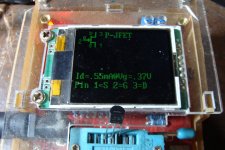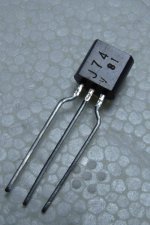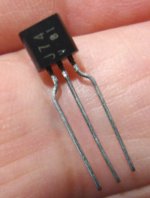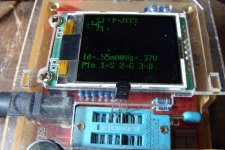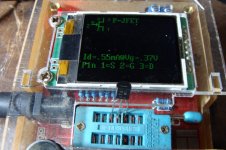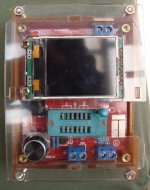Yup, nice delivery. As for my own «matching» and jigging for 10mA CCS, I have now achieved 10.02 on one resistor+113 pair and 10.07mA for the other. 0.05mA discrepancy between left and right CCS OK? Prolly a dumb question…
And maybe the answer will be that objectively it’s close enough, and so it is up to me to decide whether it is subjectively good enough. I sometimes feel I am going crazy measuring and matching, and I guess that is just the perfectionist in me pulling my leg
And maybe the answer will be that objectively it’s close enough, and so it is up to me to decide whether it is subjectively good enough. I sometimes feel I am going crazy measuring and matching, and I guess that is just the perfectionist in me pulling my leg

Last edited:
At least I admit it. Bloody Batsch! 
And thanks for the guidance 🙂 Best post a pic of my rudimentary jig, so the ZM lessons can be shared with all interested.

And thanks for the guidance 🙂 Best post a pic of my rudimentary jig, so the ZM lessons can be shared with all interested.
I wnat to thanks Ben Mah for helping me with setting up my ACP + for my HD 650 300 ohm headphones. It only took 2 days to get the resistors needed from Mouser....15 min to remove and install / add...
The HD 650's are a very nice pairing with this amp now..superlative!
Alex
Wanna share the resistor changes, and if possible also the SQ difference between stock and new values on the 600?
2sj74
I bought four 2sj74 from a member of this forum. They have all the physical characteristics of the original fet. However, when testing on a multitester, I verified that it has the source on terminal 1, the gate on 2 and the drain on 3, contrary to what is reported in the datasheet. Where did I go wrong? Or does the multitester have some error? Or is the fet not original?
I bought four 2sj74 from a member of this forum. They have all the physical characteristics of the original fet. However, when testing on a multitester, I verified that it has the source on terminal 1, the gate on 2 and the drain on 3, contrary to what is reported in the datasheet. Where did I go wrong? Or does the multitester have some error? Or is the fet not original?
Attachments
Hi, friends!
I have never tried headfi before. Soon I hope my ACP+ will be up and running, and being speakerless at the moment, I am on the lookout for some half el cheapo headphones that wil suit the ACP+.
Audeze, Sennheiser and Hifiman all have reasonably priced alternatives. But if I want something that suits the ACP, what do you recommend I look for wrt specs? Or anyone have any tips for a prime match?
For example, the Hifiman Sundaras are specced at 37 ohms. Seemingly in the ballpark. But with their planar magnetic drivers, they are said to require a bit of power from the amp iot shine, not unusual for such drivers, but… They are stated at 94db sens, but not whether that is at 1mW or 1 volt. A safe alternative would be Sennheiser, but most of them are rated at high impedances. And since buying headphones now, I would like some who shine with the circuit w/o having to change resistor values. So something that is close to the ideal approx 30 ohms is the target. Sundaras also cost a bit more than I would like to throw at them for a first go.
I guess I should take the finished amp around a few shops and test for myself 🙂
Insight appreciated,
Andy
I have never tried headfi before. Soon I hope my ACP+ will be up and running, and being speakerless at the moment, I am on the lookout for some half el cheapo headphones that wil suit the ACP+.
Audeze, Sennheiser and Hifiman all have reasonably priced alternatives. But if I want something that suits the ACP, what do you recommend I look for wrt specs? Or anyone have any tips for a prime match?
For example, the Hifiman Sundaras are specced at 37 ohms. Seemingly in the ballpark. But with their planar magnetic drivers, they are said to require a bit of power from the amp iot shine, not unusual for such drivers, but… They are stated at 94db sens, but not whether that is at 1mW or 1 volt. A safe alternative would be Sennheiser, but most of them are rated at high impedances. And since buying headphones now, I would like some who shine with the circuit w/o having to change resistor values. So something that is close to the ideal approx 30 ohms is the target. Sundaras also cost a bit more than I would like to throw at them for a first go.
I guess I should take the finished amp around a few shops and test for myself 🙂
Insight appreciated,
Andy
Last edited:
you sold your Tannoy-wannabees/cousins ?
as I said few times - nothing wrong with them, except they were evidently too small for your needs
as I said few times - nothing wrong with them, except they were evidently too small for your needs
Yes, I eventually sold them. You enlightened me about their shortcomings/wattage and current need, so the thought process has been going ever since. I want flexibility wrt amp choice, ie I want all amps in Papaland to be able to shine with the speakers I eventually choose, in the purest class A, and in the 1 watt range preferably. That goes for Mightyland assortment as well.
Ie I don’t want my speakers to dictate amp choices completely. Fynes wattage needs and insane impedance swings in the bass range limited me to the BA-3 with high voltage rails, and the F5T. Too many great amps to choose from compared to those limitations. And the BA-3 only shone with 60-62 degree heatsinks, and I sorta wanna avoid setting the house on fire. And without room for two amps at the moment, the choice was simple.
As you know well I am targeting Zu’s in the mid term, and Papa OB’s in biamp config in the long term, using a BA-3 sinked with a Sherman tank engine block for bass
Like this one:
Ford GAA engine - Wikipedia
Ie I don’t want my speakers to dictate amp choices completely. Fynes wattage needs and insane impedance swings in the bass range limited me to the BA-3 with high voltage rails, and the F5T. Too many great amps to choose from compared to those limitations. And the BA-3 only shone with 60-62 degree heatsinks, and I sorta wanna avoid setting the house on fire. And without room for two amps at the moment, the choice was simple.
As you know well I am targeting Zu’s in the mid term, and Papa OB’s in biamp config in the long term, using a BA-3 sinked with a Sherman tank engine block for bass

Like this one:
Ford GAA engine - Wikipedia
Last edited:
I will try those biiig Lii fullranges (crossoverless 18" in big OBs) for the upcoming F3, as I have big room. Headphones for me = (trips in) bedroom 😀
I bought four 2sj74 from a member of this forum. They have all the physical characteristics of the original fet. However, when testing on a multitester, I verified that it has the source on terminal 1, the gate on 2 and the drain on 3, contrary to what is reported in the datasheet. Where did I go wrong? Or does the multitester have some error? Or is the fet not original?
I had the same problem with that tester. Flip the orentation of the Jfet and test again. You will get the same result. It's the tester. Go by the data sheet
Or drop the tester and make a simple breadboard jig, test with battery or PSU. I found a lab PSU with current limiter for approx 100 dollars, best investment ever.
There is noting really wrong with the tester except the lead identification. It is my understanding that Jfets can be built physically in such a way that the source and drain are interchangeable. I don't know if the K74's are built this way.
Too right, to quote papa from link earlier today:
«Most of the little Jfets l play with, like 2SK170 / 2SJ74, are symmetric, and
you can switch Drain and Source and they work fine, even identically.»
I guess testers are useful for a bunch of reasons. But for matching and jigging / J113+resistor matching, I found the breadboard solution fast, cheap and easy, for starters at least 🙂
«Most of the little Jfets l play with, like 2SK170 / 2SJ74, are symmetric, and
you can switch Drain and Source and they work fine, even identically.»
I guess testers are useful for a bunch of reasons. But for matching and jigging / J113+resistor matching, I found the breadboard solution fast, cheap and easy, for starters at least 🙂
I marked up the picture with the terminal numbers as shown on my tester:
This is my tester. At the bottom the indications where the terminals must be inserted.
Attachments
I had the same problem with that tester. Flip the orentation of the Jfet and test again. You will get the same result. It's the tester. Go by the data sheet
It's the most likely hypothesis. When I invert the terminals, the result is the same. I have never seen reports of 2sj74 forgeries so perfect. The person who sold me has a 100% positive rating. I also measured the resistance between drain and source and found 25 ohms, within the normal range.
Too right, to quote papa from link earlier today:
«Most of the little Jfets l play with, like 2SK170 / 2SJ74, are symmetric, and
you can switch Drain and Source and they work fine, even identically.»
I guess testers are useful for a bunch of reasons. But for matching and jigging / J113+resistor matching, I found the breadboard solution fast, cheap and easy, for starters at least 🙂
well remembered!
- Home
- Amplifiers
- Pass Labs
- Amp Camp Pre+Headphone Amp - ACP+
